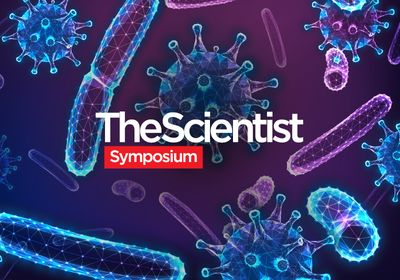ABOVE: The ciliate Pseudoblepharisma tenue harbors both green algae and purple bacteria as symbionts.
SEBASTIAN HESS
More than a century ago, a German schoolteacher named Alfred Kahl made a career change, becoming a student of protozoologist Eduard Reichenow. In 1926, when he was almost 50, Kahl published a paper in which he identified, classified, and described hundreds of new species of protists. One of those, Pseudoblepharisma tenue, is a ciliate found in the Simmelried moorland, about eight acres of wetlands in southern Germany. In his manuscript, Kahl remarked upon rose-colored bacteria and green algae living within the body of P. tenue, but no one ever followed up on that peculiar observation, until now.
In a study published June 11 in Science Advances, researchers confirm that P. tenue has two types of symbionts—a green alga and a purple bacterium—an unusual feature in a eukaryote.
“Normally, symbionts are a more specialized component, and you might get one and not the other,” says Megan Sørensen, a microbiologist at Stockholm University and Uppsala University who was not involved in the study. “These three species—the host, the purple bacteria, and the green algae—working together reveals an intricate level of metabolic integration that is really intriguing.”
Although this particular combination of organisms is unique, symbiotic interactions “are very widespread, in any sort of aquatic ecosystem,” says Matthew Johnson, a protist ecologist at the Woods Hole Oceanographic Institute in Massachusetts who did not participate in the study. These symbiotic associations are a way to expand the host’s niche and to survive in challenging environments, he adds.
As a grad student at Dalhousie University in Canada, Sergio Muñoz-Gómez, now a postdoc at Paris-Saclay University in France, focused on mitochondria. Researchers have suggested that the ancestor of mitochondria could have been a purple bacterium, he explains, but there was only a single study from 1993 that looked at purple bacteria in eukaryotes. He wanted to study that organism, but then-postdoc Sebastian Hess told him about another organism, P. tenue.
See “Mitochondria’s Bacterial Origins Upended”
Hess was familiar with P. tenue because, as an undergrad at the University of Bonn in Germany, he’d seen a 2006 book with color photos and scanning electron micrographs of microscopic organisms found in the Simmelreid moorland by independent microscopist Martin Kreutz and organismal biologist Wilhelm Foissner, then a biologist at the University of Salzburg in Austria. “I always thought, ‘well, this is interesting because it’s pink,’” says Hess. “I showed him pictures of this organism, and we agreed that this is very interesting and deserves a study.”
After varying success bringing P. tenue samples to Dalhousie University, Hess—by then a group leader at the University of Cologne in Germany—invited Muñoz-Gómez to come to Germany and study the ciliate there, where they wouldn’t have to navigate shipping them long distances. Kreutz collected the protists in southern Germany and sent them to Cologne every few weeks. By studying P. tenue in the lab, the researchers confirmed that it is around 180 microns long—about twice the diameter of a human hair—and capable of swimming quickly and phagocytosing other microorganisms.
The authors were unable to establish cultures of P. tenue, so they sequenced wild-caught samples to determine the identities of its symbionts. The green alga found inside P. tenue is most closely related to Chlorella sp. K10, which is an endosymbiont of another freshwater eukaryote, Hydra viridissima strain K10. P. tenue’s purple bacterium is most closely related to members of the genus Thiodictyon, which uses bacteriochlorophyll as a photosynthetic pigment and also metabolizes sulfur to use as an electron donor for photosynthesis. They found that the purple bacterium inside of P. tenue is missing the genes needed to metabolize sulfur, meaning that it is likely dependent upon the ciliate host, but has retained genes for photosynthesis.
Green algae are experts at photosynthesizing in oxygen-rich environments, while purple bacteria excel at photosynthesis under low-oxygen conditions. Having both symbionts may help P. tenue thrive in the variable-oxygen sediments of muddy ponds. “We have some very plausible hypotheses based on genome data [and] on microscopic observations of how the ciliate likes to live or which environments it prefers, but we want to acquire more experimental data about the kind of molecules that the symbionts are exchanging between them,” explains Muñoz-Gómez.
Testing how P. tenue’s metabolism and symbiosis affect its choice of environment would be another way to follow up, Sørensen tells The Scientist. “Actually being able to grow them in the lab and therefore doing rigorous testing in different conditions [or] having more environmental samples so that you can test different environmental conditions within the samples would be different ways to go about it,” she explains.
The nature of the relationship between the three organisms remains an open question. “We look at organisms living together, and we automatically assume that it’s beneficial,” Sørensen says, but “you also get exploitative relationships. Something they have no idea [about] here is who is benefiting and whether there’s any exploitation.”






